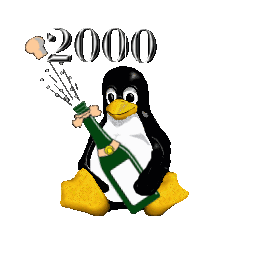
Welcome to the new Millennium. Looking back at 1999 it is really breath
taking what Linux has achieved. Linux Weekly News has published a 1999
time line.
1999 was the year of the 2.2 Kernel, Gnome, a very stable KDE and of course
the public offerings of RedHat, Cobalt Networks, VA Linux and a few other
Linux related companies.
The Gnome and KDE have very much changed the perception that Linux is
only a Server platform and the public offerings have brought a lot of
attention to Linux. 2 years ago it was often necessary to explain first
what Linux is. Now suddenly everyone seems have heard about Linux.
The Linux market is growing exponentially and I am quite sure
that this year will be even more exciting than previous years.
Despite the excitement we need to be alert. A patent lasts 20 years and
that is a very long
time in the software world. Especially in the software world
more and more patents get filed for rather
simple things. Originally patents were made to protect investment in
years of research and development. Today software patents are mostly filed
for obvious ideas and sometimes even techniques that are already in use.
These patents can block innovation and wide spread use
for a long time.
Software patents are especially a problem for developers of free software as
a patent basically makes it impossible to implement that idea as free
software. Richard Stallman has called for a boycott
against Amazon.com. Amazon, it seems, is trying to use its patent for
"one click ordering" against competitor Barnes & Noble.
The great innovative step of Amazon's patent is to store private data in a
web-browser cookie. A technique for which cookies were made after all.
 How to partition your hard drive for Linux
, by Thomas Mangin
How to partition your hard drive for Linux
, by Thomas Mangin Home Networking, glossary and overview
, by Guido Socher
Home Networking, glossary and overview
, by Guido Socher Recycling Ip Addresses with Apache
, by Atif Ghaffar
Recycling Ip Addresses with Apache
, by Atif Ghaffar VXE, a Linux security tool
, by Serge Lozovsky
VXE, a Linux security tool
, by Serge Lozovsky FSViewer, a File Manager for WindowMaker
, by Georges Tarbouriech
FSViewer, a File Manager for WindowMaker
, by Georges Tarbouriech WindowMaker the spirit of NextStep
, by Georges Tarbouriech
WindowMaker the spirit of NextStep
, by Georges Tarbouriech Perl part III
, by Guido Socher
Perl part III
, by Guido SocherThe Linux EXT2 file system usually gets a forced file system check after 20 mount counts. On todays big partitions such a file system check can take several minutes. Home and desktop computers are switched on and off more often than server machines. As a regular computer user you may therefore see the message ... has reached maximum mount count, check forced several times a week.
A file system check once in a while is a good idea but once every week or two may be too much for you. Here is how you can increase the max mount count for your partitions.
|
© 2000 LinuxFocus Go to the LinuxFocus Contact Person Page |